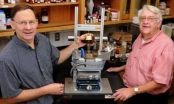(Press-News.org) Tropical Depression Nine strengthened yesterday into Tropical Storm Gaston, but today it ran into dry and stable air and weakened back into a depression again.
When NASA's Aqua satellite flew over Gaston early this morning, Sept. 2 at 0423 UTC (12:23 a.m. EDT), the infrared image taken from the Atmospheric Infrared Sounder (AIRS) instrument showed that Tropical Depression Gaston seemed to have a compact circulation with some high, cold thunderstorm cloud tops around its center of circulation. Those clouds reached so high into the troposphere that they were colder than -63 degrees Fahrenheit. Later this morning, Gaston encountered some stable and drier air, weakening it back to a tropical depression.
Visible and infrared satellite imagery late this morning showed deep convection (rapidly rising air that forms thunderstorms that power the cyclone) had decreased considerably since the AIRS image was captured, and convection and is limited to a broken band over the western and northern part of the circulation.
At 11 a.m. EDT today, Gaston's maximum sustained winds were near 35 mph, although some re- strengthening is possible as it moves into a better environment. The center of Tropical Depression Gaston was about 970 miles west of the southernmost Cape Verde Islands, or about 1500 miles east of the Lesser Antilles near latitude 14.0 north and longitude 38.9 west. The depression is moving toward the west-northwest near 7 mph and should continue in that direction for the next couple of days. Estimated minimum central pressure is 1008 millibars.
Even though Gaston is in an area of warm waters and upper level winds that will allow it to develop, the dry and stable air is keeping it weak, so re-strengthening is likely to be a slow process. For now, it is no threat to land.
###
NASA sees Depression Nine become Gaston then back to a depression
2010-09-04
ELSE PRESS RELEASES FROM THIS DATE:
Iowa State chemists discover method to create high-value chemicals from biomass
2010-09-04
AMES, Iowa – Iowa State University researchers have found a way to produce high-value chemicals such as ethylene glycol and propylene glycol from biomass rather than petroleum sources.
Walter Trahanovsky, an Iowa State professor of chemistry who likes to write out the chemical structures of compounds when he talks about his science, was looking to produce sugar derivatives from cellulose and other forms of biomass using high-temperature chemistry. And so he and members of his research group studied the reactions of cellulosic materials in alcohols at high temperatures ...
Children who eat vended snack foods face chronic health problems, poor diet
2010-09-04
ANN ARBOR, Mich. — School children who consume foods purchased in vending machines are more likely to develop poor diet quality – and that may be associated with being overweight, obese or at risk for chronic health problems such as diabetes and coronary artery disease, according to research from the University of Michigan Medical School.
The study also looked at foods sold in school stores, snack bars and other related sales that compete with USDA lunch program offerings and found that these pose the same health and diet risks in school-aged children.
"The foods that ...
NASA satellite sees Tropical Storm Kompasu transitioning over Korea and China
2010-09-04
NASA's Terra satellite captured the changing Tropical Storm Kompasu over Korea and China very early today, as it makes its way east to northern Japan. It is becoming extratropical.
The Moderate Resolution Imaging Spectroradiometer (MODIS) instrument aboard NASA's Terra satellite captured a visible image of Tropical Storm Kompasu at 02:15 UTC on Sept. 2 (10:15 p.m. EDT Sept. 1) as it was moving over Korea and China. The storm appeared disorganized as there was no visible center of circulation. The Joint Typhoon Warning Center, the organization that forecasts tropical ...
Novartis and collaborators discover novel antimalarial drug candidate
2010-09-04
Singapore, September 3, 2010 — Novartis announced today that scientists at the Novartis Institute for Tropical Diseases (NITD), in collaboration with researchers from the Genomics Institute of the Novartis Research Foundation (GNF), the Swiss Tropical and Public Health Institute and The Scripps Research Institute have discovered a novel compound that shows promise as a next generation treatment for drug resistant malaria. Major support for the project was provided by the Wellcome Trust, the Medicines for Malaria Venture (MMV), A*STAR, Singapore and the U.S. government.
Published ...
Induced pluripotent stem cell retain an inactivated X chromosome
2010-09-04
Female induced pluripotent stem (iPS) cells, reprogrammed from human skin cells into cells that have the embryonic-like potential to become any cell in the body, retain an inactive X chromosome, stem cell researchers at UCLA have found.
The finding could have implications for studying X chromosome-linked diseases such as Rett syndrome, caused by mutations in a gene located on the X chromosome.
The findings differ from those seen in mouse skin cells that are reprogrammed into iPS cells, in which the inactive X chromosome reactivates, said Kathrin Plath, senior author ...
Race, insurance status cited in uneven death rates among pedestrians hit by cars
2010-09-04
Uninsured minority pedestrians hit by cars are at a significantly higher risk of death than their insured white counterparts, even if the injuries sustained are similar, new research from Johns Hopkins suggests.
The death rate disparity is compounded by the fact that minority pedestrians are far more likely than white pedestrians to be struck by motor vehicles, according to a study published in the August issue of the journal Surgery.
"It's a double whammy," says Adil H. Haider, M.D., M.P.H., an assistant professor of surgery at the Johns Hopkins University School ...
Yale develops new animal model for hemophilia A
2010-09-04
Researchers at Yale School of Medicine have developed a new animal model for studying hemophilia A, with the goal of eventually treating people with the disorder. Hemophilia A, a hereditary defect that prevents blood from clotting normally, is caused by a variety of mutations in the factor VIII gene.
Published online in the Journal of Thrombosis and Haemostasis, the study aimed to provide a better understanding of hemophilia A, according to first author and veterinarian Carmen Jane Booth, assistant professor of comparative medicine, and co-director of Mouse Research Pathology ...
Non-invasive therapy significantly improves depression, UCLA researchers say
2010-09-04
Major depression is a common and disabling brain condition marked not only by the presence of depressed mood but also by its effects on sleep, energy, decision-making, memory and thoughts of death or of suicide.
Major depression affects 15 million adults in the U.S., and the World Health Organization projects that by 2020, it will be the largest contributor to disability in the world after heart disease.
While antidepressants have helped many to recover and resume their lives, only 30 percent of patients will experience full remission with the first medication they ...
UCLA chemists, engineers achieve world record with high-speed graphene transistors
2010-09-04
Graphene, a one-atom-thick layer of graphitic carbon, has great potential to make electronic devices such as radios, computers and phones faster and smaller. But its unique properties have also led to difficulties in integrating the material into such devices.
In a paper published Sept. 1 in the journal Nature, a group of UCLA researchers demonstrate how they have overcome some of these difficulties to fabricate the fastest graphene transistor to date.
With the highest known carrier mobility — the speed at which electronic information is transmitted by a material ...
Verbal snippets offer insights on well-being amid separation, divorce
2010-09-04
A new study from the University of Arizona shows that people in the midst of a divorce typically reveal how they are handling things – not so much by what they say but how they say it.
In fact, data revealed that even complete strangers were able to figure out how people were coping with their emotions using relatively small amounts of information.
The study, "Thin-Slicing Divorce: Thirty Seconds of Information Predict Changes in Psychological Adjustment Over 90 Days," published online in the journal Psychological Science, is one of a number of relatively recent person-perception ...


